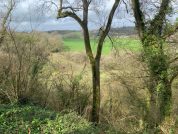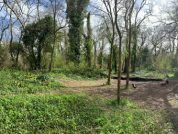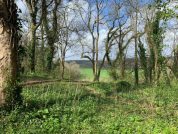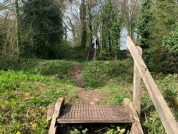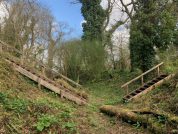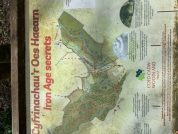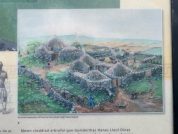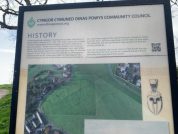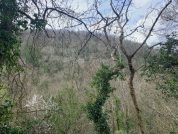Dinas Powys Hillfort
Iron Age Hillfort
The fort at Dinas Powys is a roughly oval enclosure spanning approximately 0.08 hectares, primarily defined by a broad ditched rampart with a palisade on the northern side. The entrance is located at the north-western extremity, and access to the fort would have been along the rocky spine of the steep slopes below. There are three additional lines of ramparts on the southern side, with the possibility of one continuing around the western side. The inner rampart is revetted in stone and appears to have had a timber-framed breastwork, while the second rampart, also ditched, is relatively insubstantial. The two outer ramparts are massive and seem to have been conceived as a pair, with the inner one also being revetted in stone. Traces of two rectangular buildings, up to 7.5 meters wide, have been found in the interior of the fort.
A bank and ditch known as Bank V, running south from the fort, is believed to be an old field boundary shown on the 1st edition Ordnance Survey County series map from 1880, and may have been connected with an enigmatic ’causeway’.
There is also a second defended enclosure located 130 meters away on the southern edge of the hilltop, designated as NPRN 307785. The fort at Dinas Powys does not resemble a medieval castle, but rather exhibits characteristics of a later prehistoric-style hillfort, suggesting a complex history of occupation and use of the site over time.
Dinas Powys Hillfort was previously called Cwm George or Cwrt-yr-Ala Camp.
Dinas Powys Hillfort During the Iron Age and Romano-British periods
Phase One of construction at the Dinas Powys site, which consisted of the hillfort on the northernmost tip of the hill, took place during the Iron Age, likely in the 3rd or 2nd century BCE. Evidence of Iron Age pottery and postholes found within the fort suggests that it was settled by a community during this period. Phase Two, known as Late Iron Age, occurred in the 1st century BCE and involved the construction of two Southern Banks located at the southern end of the hill, away from the main fort. However, these defenses were incomplete, as there is no evidence of a gateway between them, indicating limited defensive functionality.
Historically, hillforts were believed to be defensive structures built during a time of warfare or threats of warfare between tribal groups. The main Dinas Powys fort was considered “heavily defended” by Leslie Alcock, the excavator of the site, while the Southern Banks were less defensible.
In the 1st century CE, southern Britain was conquered and incorporated into the Roman Empire, resulting in the period of Roman Britain, where Roman and native Iron Age British cultures merged to form a Romano-British culture. This period lasted until the 4th century, when Roman armies left Britain. During this time, the Vale of Glamorgan, where Dinas Powys is located, experienced “intensive settlement” with the construction of at least three Roman villas in the vicinity, each likely associated with its own agricultural estate. However, it is debated whether the Dinas Powys hillfort remained occupied during this Romano-British period, as there is limited evidence of major features or Romano-British artefacts at the site, in contrast to other local settlement sites in the Vale of Glamorgan. Alcock noted that the Phase 3 (Romano-British) material found at Dinas Powys is insufficient to confirm a Romano-British occupation of the site in its local context.
Dinas Powys Hillfort During the Early Mediaeval period
During the post-Roman Early Mediaeval era, known as the “Early Christian period,” the hillfort saw a new phase of occupation referred to as Phase Four. This period, dating to the 5th and 6th centuries CE, saw the construction of at least two buildings within the fort, possibly made of stone rather than wood. House I was interpreted as a hall for the local lord and his family, while House II was likely a storehouse or barn for servants or laborers.
Several hearths were also constructed within the fort during Phase Four, some of which were used for industrial purposes, suggesting metal production on site. Excavators found evidence of skilled craftsmen, including blacksmiths and jewellers, who were likely migrants from Ireland employed by the lord of Dinas Powys. Notably, a burial of a young child was discovered near one of the hearths, exhibiting both Christian and pre-Christian burial traditions.
The inhabitants of Dinas Powys hillfort during this period were primarily engaged in stock-raising, particularly of cattle and sheep. However, most of the livestock appeared to be slaughtered before they could reproduce, indicating the need for regular imports to sustain the population. Excavated animal bones also revealed evidence of bread consumption, as rotary querns for grinding grain were found at the site, likely indicating local grain production. Metalworking also played a subsidiary role in the economy of Dinas Powys, and the elite traded livestock and metal products for luxury goods from other regions, such as wine, oil, and pottery from the Irish Sea and southern Europe. The quantity of Early Christian material recovered from the site, including large rubbish pits or middens, was described as the largest assemblage in Wales and the Marches, indicating a significant period of occupation and activity during the Early Mediaeval era.
During the Early Christian period, there were indications of attempts to reinforce the defenses of the site at Dinas Powys hillfort. Archaeologists identified a ditch (referred to as Ditch II) and a bank (referred to as Bank II) that were constructed during this period, as they differed significantly from the other ditches and banks known to be from the Late Mediaeval period. However, these fortifications were poorly constructed compared to the later ones, as noted by excavator Leslie Alcock.
Dinas Powys Hillfort During the Late Mediaeval period
Following the Norman invasion of Wales, during which the Norman-dominated English monarchy occupied the region, Dinas Powys hillfort continued to be utilized. In the 11th and 12th centuries CE, during what is known as Phase 5 of construction and settlement, Banks 1, 3, and 4 were constructed, significantly enhancing the defensive capabilities of the site. Excavator Leslie Alcock described these defenses as “well contrived and laboriously constructed.” Later, in the Norman era, Phase 6 of construction took place, further fortifying the site. Alcock suggested that Dinas Powys hillfort was likely not a fortified residence, but rather a military stronghold used only in times of need, possibly occupied by a tented garrison.
Finds from Dinas Powys Hillfort
The majority of finds at the site were from the early medieval period, but there were also some Roman artefacts and fragments of twelfth-century pottery. The ramparts overlay deposits containing Iron Age pottery, suggesting that the fort may have been established as late as the Roman period. It was clearly occupied during the early medieval period, and the internal buildings could potentially relate to this period or to an ambiguous phase indicated by the presence of twelfth-century pottery.
Sites near Dinas Powys Hillfort
- Caerau Hillfort, Cardiff (4 km)
Iron Age Hillfort - Caerau Hillfort, Llantrisant (4 km)
Iron Age Hillfort - Cardiff Roman Villa (5 km)
Villa - Sully Island (5 km)
Iron Age Hillfort - Cardiff (Tamion?) Roman Fort (6 km)
Saxon Shore Fort and Vexillation Fort - Cold Knap Roman Site (7 km)
Mansio and Supply Depot - The Bulwarks, Porthkerry (9 km)
Iron Age Promontory Hillfort - Bonvilston Gaer Hillfort (9 km)
Iron Age Hillfort - Llanvithyn Camp (10 km)
Iron Age Hillfort - Castell Moel hillfort (10 km)
Iron Age Hillfort
